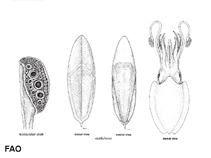Sepia orbignyana Férussac, 1826
Pink cuttlefish| Native range | All suitable habitat | Point map | Year 2050 |

|
| This map was computer-generated and has not yet been reviewed. |
| Sepia orbignyana AquaMaps Data sources: GBIF OBIS |
Classification / Names Common names | Synonyms | CoL | ITIS | WoRMS
Cephalopoda | Sepiida | Sepiidae
Environment: milieu / climate zone / depth range / distribution range Ecology
Demersal; brackish; depth range 15 - 570 m (Ref. 1695), usually 50 - 250 m (Ref. 1695). Subtropical; 55°N - 17°S, 22°W - 36°E (Ref. 107081)
Distribution Countries | FAO areas | Ecosystems | Occurrences | Introductions
Eastern Atlantic and the Mediterranean: from Irish Sea to southern Angola.
Length at first maturity / Size / Weight / Age
Maturity: Lm 7.0, range 4 - ? cm Max length : 9.6 cm ML male/unsexed; (Ref. 1695); 12 cm ML (female)
Short description Morphology
Mantle length at first sexual maturity in West Africa: 4.0-5.0 cm (male); 7.0 cm. Mantle length at first sexual maturity in western Mediterranean: 5.0 cm (males); 7.8 cm (females; Ref. 275).
Inshore (Ref. 122891). A demersal (Ref. 1695), nektonic (Ref. 417), nektobenthic (Ref. 122890) species. Found over sandy and sandy-muddy bottoms (Ref. 1695) and detritus-rich continental shelf and slope (Ref. 417). In the Sea of Marmara, the species can occur in brackish waters. In Mediterranean waters, spawning period is likely continuous as males and females are usually found together throughout the year, with peaks in activity in spring and autumn. In Portuguese waters, predominance of mature individuals in spring is also reported. No record of onshore spawning migration. With the extended reproductive period, recruitment is also continuous but variable, with seasonal density peaks. Males mature at 6 or 7 months and females at 9 or 10 months. Eggs (7 to 8.5 mm maximum diameter and proportional to female size) are laid in clusters of 30 to 40 and are attached to sponges on muddy bottoms. Diet may consist of fish and cephalopods but mainly of crustaceans. One of the most abundant cephalopod species in some areas of the Mediterranean. Taken mainly as bycatch in trawl fisheries; marketed fresh and frozen along with S. elegans and small S. officinalis and constitutes a valuable resource locally. Intense fishing pressure on this resource is reported in the Sicilian Channel. Sympatric (and confused) with S. elegans Blainville, 1827 (Ref. 1695).
Life cycle and mating behavior Maturity | Reproduction | Spawning | Eggs | Fecundity | Larvae
Members of the class Cephalopoda are gonochoric. Male and female adults usually die shortly after spawning and brooding, respectively. Mating behavior: Males perform various displays to attract potential females for copulation. During copulation, male grasp the female and inserts the hectocotylus into the female's mantle cavity where fertilization usually occurs. Life cycle: Embryos hatch into planktonic stage and live for some time before they grow larger and take up a benthic existence as adults.
Main reference
References | Coordinator | Collaborators
Jereb, P. and C.F.E. Roper (eds.). 2005. (Ref. 1695)
IUCN Red List Status (Ref. 130435)
Data deficient (DD) ; Date assessed: 15 March 2009
CITES status (Ref. 108899)
Not Evaluated
CMS (Ref. 116361)
Not Evaluated
Threat to humans
Human uses
Fisheries: commercial
| FishSource |
Tools
More information
Internet sources
BHL | BOLD Systems | CISTI | DiscoverLife | FAO(Publication : search) | Fishipedia | GenBank (genome, nucleotide) | GloBI | Gomexsi | Google Books | Google Scholar | Google | PubMed | Tree of Life | Wikipedia (Go, Search) | Zoological Record
Estimates based on models
Preferred temperature
(Ref. 115969): 11.2 - 18.2, mean 14.4 (based on 347 cells).



